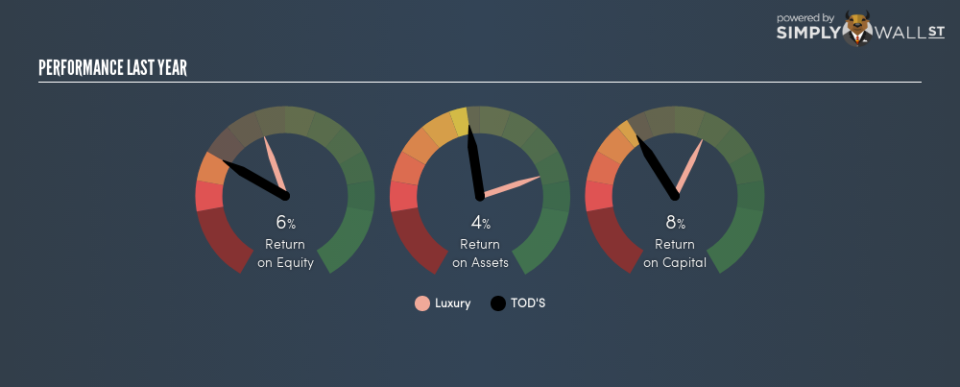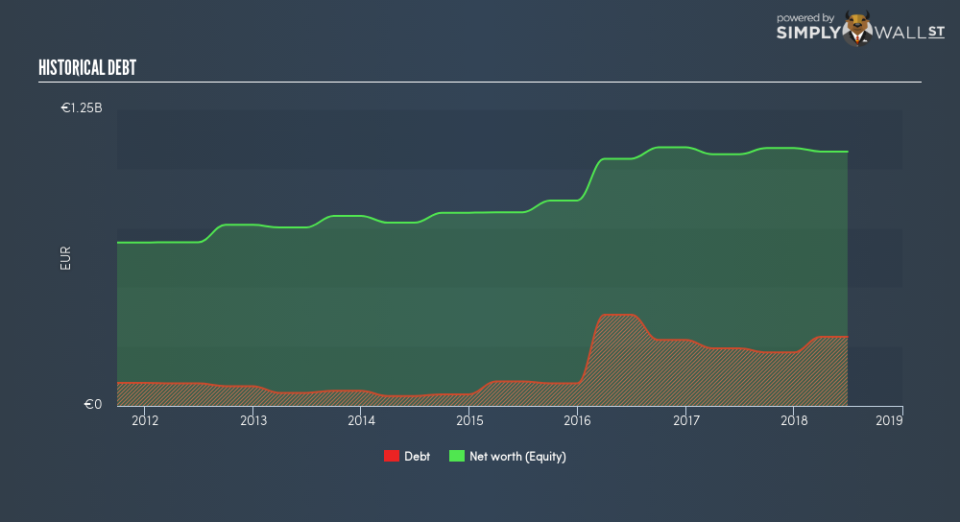Why TOD’S SpA (BIT:TOD) May Not Be As Efficient As Its Industry

I am writing today to help inform people who are new to the stock market and want to learn about Return on Equity using a real-life example.
TOD’S SpA (BIT:TOD) delivered a less impressive 6.4% ROE over the past year, compared to the 12.9% return generated by its industry. TOD’s results could indicate a relatively inefficient operation to its peers, and while this may be the case, it is important to understand what ROE is made up of and how it should be interpreted. Knowing these components could change your view on TOD’s performance. Metrics such as financial leverage can impact the level of ROE which in turn can affect the sustainability of TOD’s returns. Let me show you what I mean by this.
View our latest analysis for TOD’S
What you must know about ROE
Firstly, Return on Equity, or ROE, is simply the percentage of last years’ earning against the book value of shareholders’ equity. An ROE of 6.4% implies €0.064 returned on every €1 invested. While a higher ROE is preferred in most cases, there are several other factors we should consider before drawing any conclusions.
Return on Equity = Net Profit ÷ Shareholders Equity
Returns are usually compared to costs to measure the efficiency of capital. TOD’S’s cost of equity is 8.4%. Since TOD’S’s return does not cover its cost, with a difference of -2.0%, this means its current use of equity is not efficient and not sustainable. Very simply, TOD’S pays more for its capital than what it generates in return. ROE can be broken down into three different ratios: net profit margin, asset turnover, and financial leverage. This is called the Dupont Formula:
Dupont Formula
ROE = profit margin × asset turnover × financial leverage
ROE = (annual net profit ÷ sales) × (sales ÷ assets) × (assets ÷ shareholders’ equity)
ROE = annual net profit ÷ shareholders’ equity
Essentially, profit margin shows how much money the company makes after paying for all its expenses. Asset turnover shows how much revenue TOD’S can generate with its current asset base. And finally, financial leverage is simply how much of assets are funded by equity, which exhibits how sustainable the company’s capital structure is. Since ROE can be inflated by excessive debt, we need to examine TOD’S’s debt-to-equity level. Currently the debt-to-equity ratio stands at a low 27.2%, which means TOD’S still has headroom to take on more leverage in order to increase profits.
Next Steps:
ROE is one of many ratios which meaningfully dissects financial statements, which illustrates the quality of a company. TOD’S’s below-industry ROE is disappointing, furthermore, its returns were not even high enough to cover its own cost of equity. Although, its appropriate level of leverage means investors can be more confident in the sustainability of TOD’S’s return with a possible increase should the company decide to increase its debt levels. Although ROE can be a useful metric, it is only a small part of diligent research.
For TOD’S, I’ve compiled three relevant aspects you should look at:
Financial Health: Does it have a healthy balance sheet? Take a look at our free balance sheet analysis with six simple checks on key factors like leverage and risk.
Valuation: What is TOD’S worth today? Is the stock undervalued, even when its growth outlook is factored into its intrinsic value? The intrinsic value infographic in our free research report helps visualize whether TOD’S is currently mispriced by the market.
Other High-Growth Alternatives : Are there other high-growth stocks you could be holding instead of TOD’S? Explore our interactive list of stocks with large growth potential to get an idea of what else is out there you may be missing!
To help readers see past the short term volatility of the financial market, we aim to bring you a long-term focused research analysis purely driven by fundamental data. Note that our analysis does not factor in the latest price-sensitive company announcements.
The author is an independent contributor and at the time of publication had no position in the stocks mentioned. For errors that warrant correction please contact the editor at editorial-team@simplywallst.com.

 Yahoo Finance
Yahoo Finance 

